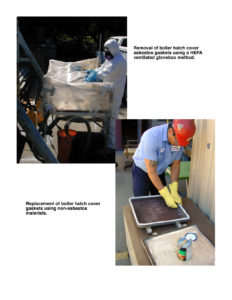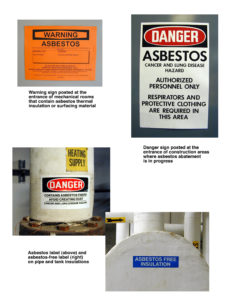
Asbestos is a common name given to a group of naturally occurring mineral fibers. The Greeks are known to have woven the fibers into lamp wicks as early as the 5th Century B.C. Modern commercial use of asbestos began with the industrial revolution in the late 19th Century. Asbestos has since been incorporated into a wide variety of building products due to its abundance, low cost, strength, flexibility and insulating qualities. Adding asbestos to soft materials such as pipe insulation and acoustic plaster was banned in the U.S. by the late 1970s.

However, even today, asbestos can still be added to products that encapsulate or otherwise bind the fibers such as vinyl floor tile, cement pipe and asphalt roofing. While U.S. production has diminished, asbestos-bearing ores are found worldwide and countries such as Canada and Brazil remain major manufacturers and exporters of asbestos products.
Asbestos-Containing Materials in Stanford University Buildings
Asbestos-containing materials are known to be present in many of the buildings on campus. In some areas, asbestos has been identified in one or more of the products listed below. Click on the product to view a representative photo.
- Spray-applied fireproofing
- Pipe, tank & boiler insulation
- Air duct seam tape & vibration cloth
- Air & furnace duct insulation
- Gaskets, oakum & muffler insulation
- Cement pipe, flue, conduit & exhaust duct
- Corrugated & flat cement siding
- Cement pegboard & bender board
- Roofing tar, felt, mastic & shingles
- Plaster & sheetrock joint compound
- Acoustic ceiling or wall tile & adhesives
- Floor tile, sheet vinyl, linoleum & adhesives
- Basecove & ceramic tile adhesives
- Lab counter tops, equipment insulation & fume hood liners
- Door & wire insulation
- Caulking & glazing compounds
What are the hazards?
Asbestos is only a hazard when small particles become airborne, are inhaled and deposited within the lungs. Increased incidence of several illnesses including asbestosis, a debilitating lung disease, lung cancer and mesothelioma, a rare cancer of the lung or stomach cavity lining, have been observed in individuals who were persistently exposed to high levels of airborne asbestos in work environments such as mining, milling, shipbuilding, construction and manufacturing. Asbestos-containing materials in buildings pose no risk to health unless asbestos fibers become airborne and are inhaled. Intact, sealed and undisturbed materials are not a hazard.
Construction products in good condition will not release asbestos particles into the air. Hard products such as vinyl floor tile and cement shingles contain binders that completely encapsulate the asbestos for added protection. Asbestos in soft products such as pipe insulation may be completely sealed within a canvas or steel jacket. Walls, ceilings and floors may also act as barriers that separate occupied building areas from asbestos products found in mechanical rooms, crawlspaces and attics.
How can I protect myself?
EH&S is involved in an on-going effort to survey and identify asbestos-containing materials in the nearly 800 buildings on campus. If these materials are to be disturbed through demolition, building repair or abatement, specific safeguards (see photo below), must be followed to prevent exposure. Signs and labels (see photo below) are also used to demarcate asbestos products and abatement activities.
All renovation or demolition of campus buildings must be reviewed in advance by EH&S. If survey information is not available, EH&S will conduct a survey and designate acceptable safe work practices for abating asbestos-containing materials. Work that requires removal or repair of asbestos-containing material or the testing of suspect material is restricted to trained and certified individuals working under the direct supervision of EH&S.
Individual Protective Measures
Use the following measures to protect you and others from exposure to airborne asbestos:
- Presume all building materials contain asbestos until proven otherwise by EH&S.
- Do not remove, cut, drill, sand, grind or otherwise disturb any material that may contain asbestos.
- Do not go above ceilings, behind walls or into building spaces such as attics and crawspaces unless these areas have been inspected and cleared by EH&S.
- Do not pull cable or wiring through above-ceiling spaces with asbestos.
- Do not install screws, pins, nails or hangers into asbestos ceiling or wall plasters.
- Be careful not to damage walls, ceilings or floors when moving furniture or equipment.
- Do not brush, sweep or vacuum textured asbestos ceiling plaster or plaster debris.
- Immediately report any observed damage or deterioration of suspect building materials to your supervisor, building manager, Facilities Zone Manager or EH&S.


